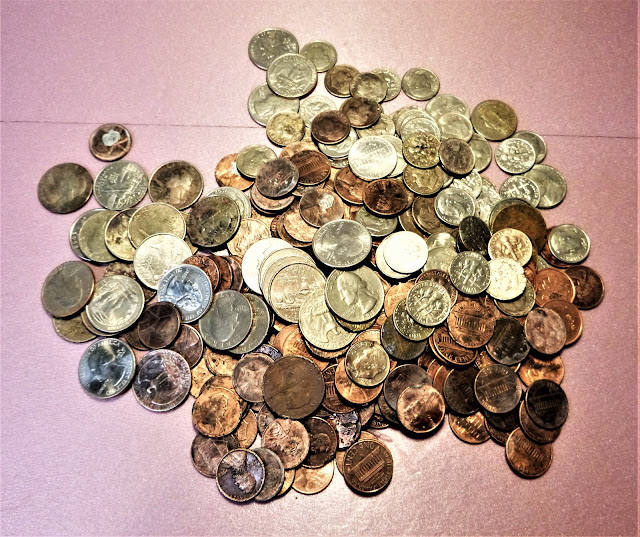Today I am supposed to be in sunny England, happily troweling away at a Britano-Roman site. I should be intently watching each careful scrape looking for both the spectacular and the mundane, as each can contribute to our understanding of the past.
But no, for the first time in 13 years there is no spring archaeology trip.
I never entirely turn off the "radar" that makes me a good excavator. I'm always scanning my surroundings, looking for things that don't quite fit and might be hints of something atypical. It's probably why I was a better than average diagnostician back in my medical career. Maybe I even stayed a step or two ahead of my teen aged kids and whatever they were up to. At least for a while.
I try to walk every day. It's harder during the winter, but as soon as I can delude myself that spring is coming I am tromping about town. And of course, scanning my surroundings.
I run across a lot of lost coins, and into my pocket they go. At home they go into a jar. When our bank stopped happily accepting batches of coins they started accumulating, so the sizable hoard I set out to clean recently was at least two years worth.
So what can be learned from a frankly random collection that comes from so many sources? Do the presumably rowdy patrons of the Sunbeam Tavern and those of the now quarantined Burger King and the hormonally distracted denizens of the High School parking lot have enough points in common to describe our community?
Lets find out. Here's a small view of the batch before cleaning.
I'll try to do a semi-professional job of analyzing these finds, with notes for future scholars....
Here's the hoard after several days of lackadaisical cleaning efforts. Not bad actually.
It adds up to 34 quarters, 54 dimes, 26 nickles and 198 pennies. Oh, plus the following foreign issues, which likely ended up coming home from overseas travels. Sometimes they were coins I found on walks over there:
- an old UK 20 pence, a 10 pence "New Pence" from 1992 and a 2008 UK penny.
- a 2002 10 euro cent piece
- 6 Canadian pennies and one quarter.
If dates interest you the oldest coins were a pair of 1964 pennies. The newest finds were from 2019.
About half the quarters were commemoratives. None were from Wisconsin or adjacent states.
The biggest batch of course were the pennies. You drop one and you can hardly be bothered to look for it. Note the huge difference in quality between old and new.
Newer US coins, other than the nickles, all have base metal cores and a thin wash of something that at least tries to look like the copper and silver of bygone times. This makes them easily damaged especially in places where a snow plow goes back and forth repeatedly.
Coin hoards are used to gain insight into times past. Was there inflation? Were times rich or poor? Even modern coin accumulations have been studied. There are all sorts of factors that go into what is found. How many of each type were made? What was saved by collectors? What denominations stayed in use for things like vending machines and bus fares?
With the insidious growth of electronic transactions I am pretty sure that coinage as we've known it for several millenia will vanish in the next generation. And far future archaeologists will likely have a hard time figuring out this now unfamiliar technology.
So here, Far Future Archaeologists, let me make your job easier.
Little known fact. Abraham Lincoln slowly turned into a zombie.
It started in 1997.....
And the horrifying process was complete by 2008.
Abe Lincoln. Zombie. Start writing your Doctoral theses Future Peeps....






1 comment:
This was a very interesting episode especially digging the coins out of the caverns and then cleaning them. https://www.history.com/shows/modern-marvels/season-15/episode-26
Post a Comment